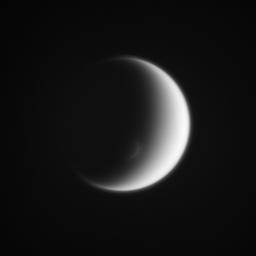
|
Titan’s Crescents
- Click the image above for a larger view
- Full-Res JPEG (1020 x 1020) (21.1 kB)
- Full-Res TIFF (1020 x 1020) (1.0 MB)
Caption:
Titan's south polar vortex mimics the moon itself, creating an elegant crescent within a crescent. Situated above the surrounding polar atmosphere, the raised walls along the sunward side of the vortex just catch the grazing sunlight, creating a crescent of its own.Titan (3,200 miles, or 5,150 kilometers across) is Saturn's largest moon and possesses a dense and dynamic atmosphere. For a color image of the south polar vortex on Titan, see PIA14919 . For a movie of the vortex, see PIA14920 .
This view looks toward the trailing hemisphere of Titan. North on Titan is up. The image was taken with the Cassini spacecraft wide-angle camera on Dec. 1, 2013 using a spectral filter which preferentially admits wavelengths of near-infrared light centered at 939 nanometers.
The view was obtained at a distance of approximately 108,000 miles (174,000 kilometers) from Titan. Image scale is 6 miles (10 kilometers) per pixel.
Background Info:
The Cassini-Huygens mission is a cooperative project of NASA, the European Space Agency and the Italian Space Agency. NASA's Jet Propulsion Laboratory, a division of the California Institute of Technology in Pasadena, manages the mission for NASA's Science Mission Directorate, Washington. The Cassini orbiter and its two onboard cameras were designed, developed and assembled at JPL. The imaging operations center is based at the Space Science Institute in Boulder, Colo.
For more information about the Cassini-Huygens mission visit http://saturn.jpl.nasa.gov and http://www.nasa.gov/cassini . The Cassini imaging team homepage is at http://ciclops.org .
Cataloging Keywords:
| Name | Value | Additional Values |
|---|---|---|
| Target | Titan | |
| System | Saturn | |
| Target Type | Satellite | |
| Mission | Cassini-Huygens | |
| Instrument Host | Cassini Orbiter | |
| Host Type | Orbiter | |
| Instrument | Imaging Science Subsystem (ISS) | |
| Detector | Wide Angle Camera | |
| Extra Keywords | Atmosphere, Grayscale, Infrared, Visual | |
| Acquisition Date | ||
| Release Date | 2014-05-05 | |
| Date in Caption | 2013-12-01 | |
| Image Credit | NASA/JPL-Caltech/Space Science Institute | |
| Source | photojournal.jpl.nasa.gov/catalog/PIA17163 | |
| Identifier | PIA17163 | |
